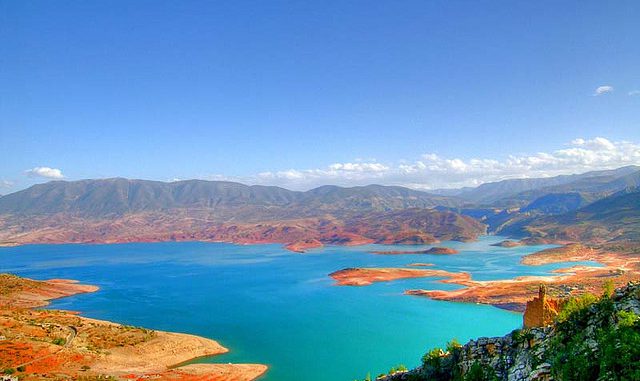
The capacities of the Kingdom’s agricultural dams are on average at their lowest historical level. The Bine El Ouidane dam has even reached the alert level, as has the Abdelmoumen dam and several others.
“The reserves of the dam [Bine El Ouidane] are almost dry. You can even cross on foot through places where there was plenty of water a few years ago,” says a farmer from Afourer.
The first town downstream from the Bine El Ouidane dam, Afourer is part of the Tadla plain. Fruit trees are abundant there, unlike the agricultural water resources. Even though the Bine El Ouidane dam is at most forty kilometres away.
According to the General Directorate of Water, part of the Ministry of Public Works, as of 21 January, the Bine El Ouidane dam, with a capacity of 1.2 billion cubic metres, had a filling rate of 14.3%. “It could even be that this rate is much lower in reality,” says an inhabitant of the rural commune where the dam is built, referring to the silt.
This situation is due to the delay of the rains. But also to the overexploitation of the dam’s capacities, whose “reserves are solicited more than necessary”, says another farmer. “In addition to the fact that the reserves are continuously pumped for the needs of the Tadla plain, part of its water is also allocated to other regions,” he says.
Indeed, in addition to the water allocated to the Doukkala, part of the reserves of the Bine El Ouidane dam are redirected to the Marrakech-Safi region. In this case, the agricultural plains of El Kelâa des Sraghna, located more than a hundred kilometres from the dam.
Contacted by us, Abdellah Bourak, director of the Oum Rebiaa water basin agency, confirms: “It’s been about twenty years since the canal, in this case the Tassaout wadi, which carries water from the Bine El Ouidane dam to El Kalaa de Sreghna, was created as part of a state policy. It is an ideal project from a macro-economic point of view because it reduces the disparities in development between regions. El Kalaa de Sreghna needed this canal for its economic development. The irrigation problems encountered by the farmers of Afourer are legitimate because this is the fifth consecutive year of drought. But at the moment, we are managing for the moment. We cannot respond to their grievances because we have no control over rainfall. In general, we are focusing on the supply of drinking water first. Secondly, we try to save 30-year-old trees, not to increase their production, but only so that they don’t die.
In the region of Sraghna-Zemrane, the olive tree is the main arboricultural sector. The olive sector is an important source of employment in the region, with more than 4.7 million working days per year, the equivalent of 23,500 permanent jobs.
Enough to justify the allocation of part of the Bin El Ouidane dam’s reserves to El Kelâa des Sraghna? Not for one of the two farmers contacted. “This has important repercussions on the crops of Afourer,” he says. And he adds: “This decision, which dates back, has practically signed our death warrant.

Be the first to comment